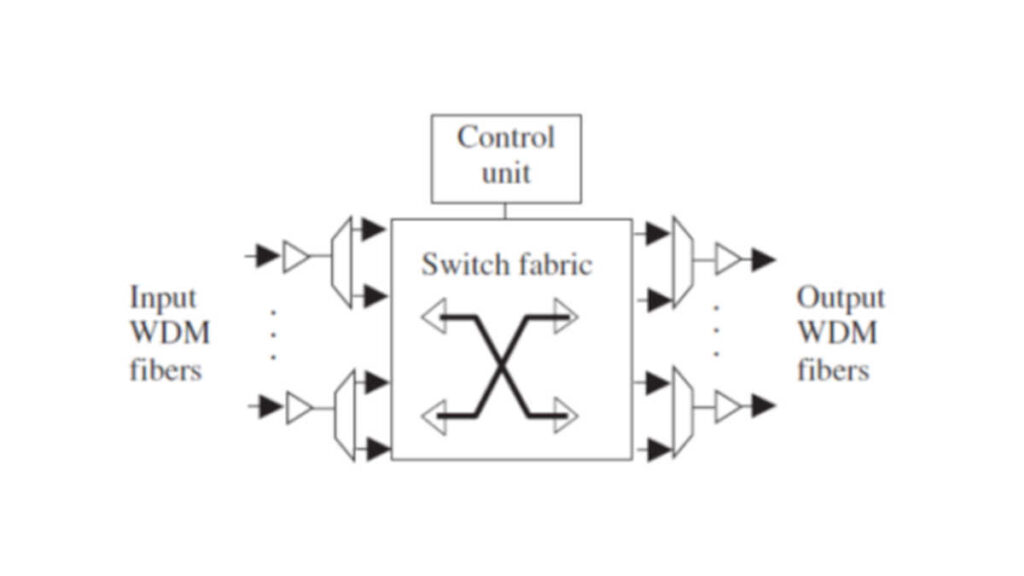Optical Burst Switching, also known as OBS, is a different optical networking scheme, which is better suited for the transmission of bursty traffic.
In a wavelength-routing optical network, a connection has to be set up before data will be transmitted. The resources remain allocated to this connection even when there is no traffic transmitted. Taking that into account, connection use can be low when the traffic is bursty.

But, to better understand OBS, let’s start to define Burst Switching.
What is Burst Switching?
In a packet-switched network, burst switching is the ability of each network switch extracts routing information from an incoming packet header to establish and maintain the appropriate switching connection for the duration of the packet, after which the connection will be released.
Conceptually, burst switching is similar to a connectionless-mode transmission, but it differs in that burst switching implies an intent to establish the switch connection in near real-time so that only minimum buffering is required at the node switch.
Main features of optical burst switching
Optical Burst Switching (OBS) was designed to efficiently support the transmission of bursty traffic over an optical network. OBS was based on the ATM block transfer (ABT), an ITU-T standard for burst switching in ATM networks.
An OBS network consists of OBS nodes interconnected with WDM fiber in a mesh topology. An OBS node is an OXC (Optical Cross Connect). It consists of amplifiers, multiplexers/demultiplexers, a switch fabric, and an electronic control unit (see next Figure: Reference OBS node).

The OBS node can switch an optical signal on wavelength λi of an input fiber to the same wavelength of an output fiber. If it is equipped with converters, it can switch the optical signal of the incoming wavelength λi to another free wavelength of the same output fiber, should wavelength λi of the output fiber be in use. (Assume that full conversion applies and that each converter can convert an optical signal to any other wavelength). Unlike wavelength routing networks, where a connection can remain active for a long time, the switch fabric of an OBS node demands an extremely short configuration time.
The OBS network
The OBS network is accessed by OBS end devices, which are IP routers, ATM switches, or frame relay switches, equipped with an OBS interface. (Devices that produce analog signals, such as radar, can also be attached to the OBS network.) Each OBS end device is connected to an ingress OBS node.
An OBS end device collects traffic from various electrical networks, such as ATM, IP, and frame relay, and it then transmits it to destination OBS end devices optically through the OBS network. The collected data is sorted based on a destination OBS end device address and is assembled into larger size units, called bursts.
As shown in the next Figure, in order to transmit a burst, the end device first transmits a control packet, and after a delay, known as the offset, it transmits its burst. The control packet contains information such as the burst length and the burst destination address. It is basically a request to set up a connection (i.e., a lightpath, end-to-end). After the transmission is completed, the connection is torn down.

As in wavelength routing networks, two adjacent OBS nodes can be linked by one or more optical fibers, each carrying W wavelengths. Therefore, up to W bursts per fiber can be simultaneously transmitted out. An end device might also have the ability to transmit W bursts to its ingress OBS node simultaneously, or it might have only one wavelength available on which to transmit one burst at a time.
Control packets can be transmitted either optically (on a designated signaling wavelength) or electrically (over a packet-switching network, such as an IP or ATM network).
In either case, the control packet can only be electronically processed by each OBS node. This means that if it is transmitted in the optical domain, it will have to be converted back to the electrical domain. As can be seen, there exists a separation of control and data, both in time and physical space. This is one of the main features of Optical Burst Switching. It facilitates efficient electronic control while it allows for great flexibility in the format and transmission rate of the user data since the bursts are transmitted entirely as optical signals which remain transparent throughout the network.
Time Efficiency
The time it takes for the connection to be set up depends on the end-to-end propagation delay of the control packet, the sum of all of the processing delays of the control packet at all of the intermediate OBS nodes, and configuration delays. (Depending upon the propagation delay between adjacent OBS nodes, the configuration at each node might overlap to some extent.)
The time it takes for a burst to reach the destination end device is equal to the end-to-end propagation delay, since it is transmitted as an optical signal that traverses the OBS switches without any processing or buffering delays. In view of this, the transmission of a burst is delayed by an offset so that it always arrives at an OBS node, after the control unit of the node had the chance to process the control packet associated with the burst and configure the OXC. Let tproc be the time it takes to process a control packet at a node, tconf be the time it takes to configure an OXC, and N the total number of OBS nodes along the path of the burst. Then, a good upper bound for the offset can be obtained using the expression: Ntproc + tconf.
Need to learn more about Optical Burst Switching
This article is just an introduction to this topic. To learn more, we recommend that you read directly from our source. To do so, you should read chapter 10 of the following book:
- Connection-Oriented Networks – SONET, SDH, ATM, MPLS and Optical Networks, by Harry G. Perros (find it on Amazon)